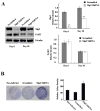Shp2 suppresses PyMT-induced transformation in mouse fibroblasts by inhibiting Stat3 activity
- PMID: 21056449
- PMCID: PMC3008596
- DOI: 10.1016/j.virol.2010.09.032
Shp2 suppresses PyMT-induced transformation in mouse fibroblasts by inhibiting Stat3 activity
Abstract
We have examined the effect of expression of the protein tyrosine phosphatase Shp2 on transformation by the mouse polyoma virus middle T antigen (PyMT). Gain-of-function mutations in Shp2 indicate that it may serve as an oncogene in several types of human leukemia. Paradoxically, however, some catalytically dominant-negative mutations of Shp2 have also been identified in leukemia and neuroblastomas. In this study, we show that Shp2 suppresses transformation induced by PyMT, the major polyoma viral oncoprotein known to act through binding and activation of pp60(c-src). Over-expression of a catalytically inactive Shp2 mutant in NIH3T3 cells significantly enhanced PyMT-induced transformation. Conversely, re-introduction of Shp2 into Shp2-deficient cells strongly inhibited PyMT-induced transformation and tumorigenesis. Short hairpin RNA (shRNA)-mediated Shp2 knockdown potentiated PyMT-induced transformation. Finally, we present evidence that the transformation-suppressive effects of Shp2 are mediated at least partially through the inhibition of signal transducers and activators of transcription 3.
Copyright © 2010 Elsevier Inc. All rights reserved.
Figures




Similar articles
-
The polyomavirus middle T-antigen oncogene activates the Hippo pathway tumor suppressor Lats in a Src-dependent manner.Oncogene. 2015 Aug 6;34(32):4190-8. doi: 10.1038/onc.2014.347. Epub 2014 Nov 3. Oncogene. 2015. PMID: 25362852
-
ShcA and Grb2 mediate polyoma middle T antigen-induced endothelial transformation and Gab1 tyrosine phosphorylation.EMBO J. 2001 Nov 15;20(22):6327-36. doi: 10.1093/emboj/20.22.6327. EMBO J. 2001. PMID: 11707404 Free PMC article.
-
Ethacrynic acid inhibits STAT3 activity through the modulation of SHP2 and PTP1B tyrosine phosphatases in DU145 prostate carcinoma cells.Biochem Pharmacol. 2020 May;175:113920. doi: 10.1016/j.bcp.2020.113920. Epub 2020 Mar 19. Biochem Pharmacol. 2020. PMID: 32201212
-
The tyrosine phosphatase SHP2 controls TGFβ-induced STAT3 signaling to regulate fibroblast activation and fibrosis.Nat Commun. 2018 Aug 14;9(1):3259. doi: 10.1038/s41467-018-05768-3. Nat Commun. 2018. PMID: 30108215 Free PMC article.
-
Structure, function, and pathogenesis of SHP2 in developmental disorders and tumorigenesis.Curr Cancer Drug Targets. 2014;14(6):567-88. doi: 10.2174/1568009614666140717105001. Curr Cancer Drug Targets. 2014. PMID: 25039348 Review.
Cited by
-
TLR4-Mediated Recognition of Mouse Polyomavirus Promotes Cancer-Associated Fibroblast-Like Phenotype and Cell Invasiveness.Cancers (Basel). 2021 Apr 25;13(9):2076. doi: 10.3390/cancers13092076. Cancers (Basel). 2021. PMID: 33923020 Free PMC article.
-
STAT3 pathway in cancers: Past, present, and future.MedComm (2020). 2022 Mar 23;3(2):e124. doi: 10.1002/mco2.124. eCollection 2022 Jun. MedComm (2020). 2022. PMID: 35356799 Free PMC article. Review.
-
The polyomavirus middle T-antigen oncogene activates the Hippo pathway tumor suppressor Lats in a Src-dependent manner.Oncogene. 2015 Aug 6;34(32):4190-8. doi: 10.1038/onc.2014.347. Epub 2014 Nov 3. Oncogene. 2015. PMID: 25362852
References
Publication types
MeSH terms
Substances
Grants and funding
LinkOut - more resources
Full Text Sources
Miscellaneous

